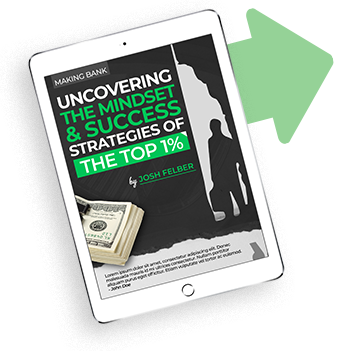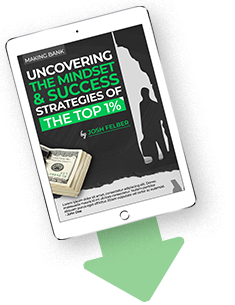3 Storytelling Strategies to Build Your Audience and Increase Sales
with Ian Stanley
Video:
Audio:
with guest Ian Stanley #MakingBank S4E18
What if you could build an audience for your product or services that were so addicted to your words that the subject line in your emails didn’t matter. You could be so confident that the emails you send out will be opened that you don’t even care what the subject line says.
I’m here to tell you that not only is this possible, but it isn’t even complicated. It all comes down to telling a story. And not just any story, but your story. The key to building a loyal audience that consistently buys your products and services is creating a bond. Your audience needs to know you. They need to feel connected to you and to see their own lives in the stories you share about yourself.
The good news is that this doesn’t take a whole lot of technical skill. You don’t need an advanced degree or years of professional writing under your belt to share a compelling story that others can connect to. I am going to share three strategies to find the right stories to tell and make sure they are compelling enough to get your audience hooked and connected to you. This is all about building authentic trust between you and your ideal customer so they can feel confident in deciding to exchange their hard-earned cash for whatever it is you may be offering to them.
STRATEGY 1: Tell the story you’re afraid to tell
This first strategy is not complicated, but it is not necessarily easy. Telling a compelling story requires vulnerability. You might be able to come up with some decent stories off of the top of your head – surface level stories. Maybe they are sort of funny, maybe they seem like a perfect way to talk about your new product.
But do they scare you? Does the story your telling feel like a bit of a risk? If the answer is no, then this story is probably not going to build a raving, loyal audience. Those surface-level stories are not going to feel real and your audience will know. They are safe and calculated. Fake.
The type of stories we’re talking about here – the stories that really click with your audience and compel them to action – need to be vulnerable and real. Authentic. Dig deep and find the story that really scares you, but it is your truth. This is the story that other people will see their lives in and this is the story that will ring true and build trust.
A great exercise here to get the vulnerability juices flowing is to think of your most embarrassing story. Challenge yourself to tell that story. Even if that just means writing it down for yourself or maybe sharing it with your close circle of people. This can help you realize the power of connection found in those raw types of stories as well as the real humor in our shared vulnerability.

STRATEGY 2: Tell stories that are emotionally driven
The second strategy to effectively use storytelling to connect with your audience is to find the stories that are emotionally driven. The purpose of telling a vulnerable story isn’t just in the shared vulnerability, but also in the emotional charge that vulnerability carries. When you’re telling the story that is scary for you, that story is likely to be highly emotionally driven. That emotion will deliver your story with a much greater impact than something with no risk and no attachment.
This strategy not only helps your audience feel connected to you and your story, but it will help convert their connection into actual sales. The more people feel, the more they are willing to spend. We all like to believe that we make purchases from a rational space in our minds. Weighing our options and choosing the best possible product or service, but we also know, deep down, this isn’t true. Maybe sometimes, but more often than not, we are purchasing things based on how we feel. There is the reason we actually buy – how the marking, copy, and product or services made us feel – and there is the reason we tell ourselves and others we buy – the logical problem the product or service will solve.
If you can tap into your own emotions and tell the stories that make you feel something, you will be able to make your audience feel something too. The more people feel, the more they will spend. This doesn’t have to feel gross either. When you are passionate about your product or service and you know it will truly help your customer, the stories you tell them will be authentic and your real emotions will connect with them.
STRATEGY 3: Make the first line irresistible
This last strategy is possibly the most important. If you are going to spend any time on creating, editing and tweaking your content, make sure you turn your focus to the first line. This is because the first line in any story is what your audience will use to determine whether they are going to continue reading. The importance of the first line cannot be overstated.
You might have the most incredible offer waiting at the end of your email, but if your first line doesn’t get your reader hooked they are never going to make it all the way down to that offer. I really suggest spending some time here at the beginning, and figure out what needs to be said to get your audience to keep reading.
A great place to start your story is somewhere in the middle. Picking a point in the middle and building the rest of the story around that moment is a great way to get your reader engaged and committed to figuring out led to that moment and how exactly the story will be resolved. This first-line strategy will elevate your stories to the next level to keep your audience coming back for more.
Topics
- Accelerated Learning
- Artificial Intelligence
- Become Present
- Blockchain
- Branding
- Business
- Education
- Entrepreneurship
- Family
- Finance
- Health
- Health & Wellness
- Internet Marketing
- Investing
- Leadership
- Lifecoach
- Marketing
- Negotiation
- Performance
- Productivity
- Publicity
- Real Estate
- Sales
- Sales Success Habits
- Video Marketing
- Writing
















